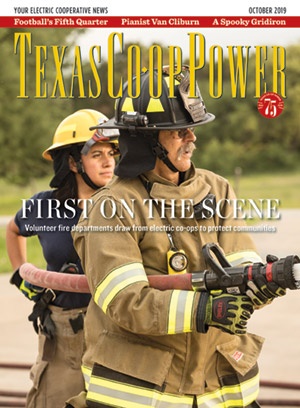Every sports fan witnesses moments of inexplicable athleticism or a notable lack thereof: A baseball player misses an easy grounder; a basketball player hits a last-second jumper with eyes closed; or a football player running for a game-winning touchdown trips in the open field. When such things happen on San Saba’s football field, the locals don’t ask why because they know the reason: spirits!
I visited Rogan Field on a cold February day, when the wet chill seemed to penetrate directly to my bones. My first impression was that this field looked like a normal high school football field: 120 yards long, goal posts at each end and a scoreboard painted in Armadillo purple and gold. But what I couldn’t see, and what makes Rogan Field eerily different, were the legends buried 6 feet below the turf. This field was built on top of a pioneer cemetery.
The tale begins in 1934, when San Saba’s high school football team played on the infield of a horse track north of town. The team desperately needed a field closer to campus, and the coaches found the perfect lot adjacent to the Methodist church. The only problem was that this lot was already occupied, and the inhabitants would not move. Since 1858, the property had been an early settler cemetery, but after years of neglect, it was overgrown and weedy. This wouldn’t have been a problem, except that when the Rogan family donated the land, they stipulated that it be maintained.
Even so, the team seized the opportunity. The Rogan family gifted the land to the school, calling on all folks to come and claim the re-mains of their loved ones. As the season approached, with numerous bodies still unclaimed, the players simply moved the remaining tombstones and left the bodies to become the team’s first season ticket holders.
Since that 1935 football season, San Saba has enjoyed an otherworldly home-field advantage that gives new meaning to the term “school spirit.” Lucky for the Armadillos, the resident spirits seem to like their new placement and regularly perform strange feats in favor of the home team. Opposing players drop passes or trip for no apparent reason, leading fans to conclude that the spirits must be reaching up from the grave.
The Armadillos have used this legend to wage psychological warfare against opponents. Brad McCoy (father of former Longhorns quarterback Colt McCoy), who coached at San Saba 1989–1994, even placed a sign saying “Welcome to the Graveyard” near the visiting team’s locker room. No team has been more cursed than the Goldthwaite Eagles, who won two state championships in the 1990s yet lost four consecutive times at Rogan Field.
Knowing the field’s history, I expected to see an apparition in full uniform floating above the turf or a sign touting the field’s ghostly origin. Sadly, I saw the stadium has been completely wiped clean of any reference to the graveyard. The current coaches seem more focused on winning games the traditional way than relying on help from the beyond.
But regardless of whether the team will acknowledge their presence, I’m sure that when the game is on the line, everyone on the home sideline is hoping the spirits will rise up once more and pull out another mysterious feat to help the Armadillos. For many Texans, high school football has always been a life-or-death matter. But perhaps the folks in San Saba have figured out that sometimes it can be both life and death.


